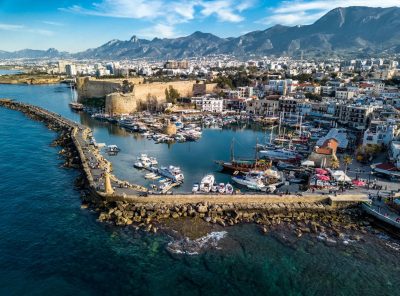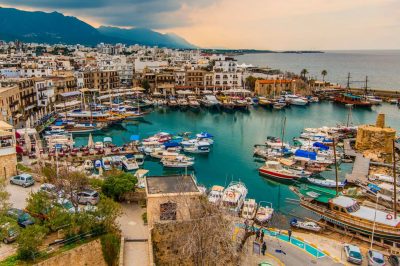


Kyrenia has existed since the 10th century BC. Excavations have revealed Greek traces that date back to the 7th century BC, but the site was developed into a city under Roman rule.
In its heyday, just before the British occupation of the island in 1878, Kyrenia Harbour was a quiet, often ignored, port between Cyprus and other countries in Europe and the Middle East. From there local Caïques, Cypriot-owned - Greek and Turkish Cypriot - and Greek-owned, conducted a thriving trade. Depending on the season, they exported wheat and olives, donkeys and goats and much more. Larger boats, mostly from Europe, arrived in the late fall and early winter to take in the crop of carobs, the main export item of the area. The caiques brought in wood, earthenware, legumes, cheese, butter, and even small luxurious items such as silk and cotton cloth, buttons and odd pieces of furniture. Slowly, two-storied buildings emerged around the harbour as the owners used the lower floor as warehouses and the second floor as their residences.
The town's trade with the Anatolian coast and beyond the Levant sea was badly affected when in 1885, the then-British government of the island began the Kyrenia harbour works that left the Harbour wide open to the northern gales. In its heyday, just before the British occupation of the island in 1878, local caïques (traditional fishing boats) conducted a thriving trade from Kyrenia Harbour. Depending on the season, they exported wheat and olives, carobs, donkeys and goats and more. The caiques brought in wood, earthenware, legumes, dairies and small luxuries items such as silk and cotton cloth, buttons and odd pieces of furniture. Larger boats, mostly from Europe, arrived in the late fall and early winter to take in the crop of carobs, the main export item of the area also known as “Cyprus Black Gold” for the abundance of wealth it brought to the island. Slowly, two-storied buildings emerged around the harbour as the owners used the lower floor as warehouses and the second floor as their residences. Today Kyrenia Harbour is full of yachts and fishing boats and framed by the colossal hulk of its Crusader castle. With the backdrop of the jagged mountains behind and the calm sparkling sea in front, the harbour has an intoxicatingly serene atmosphere.
The graceful arc of the harbourside is filled with the tables of restaurants and cafés, ideal for sitting back and simply watching the world go by. The former carob warehouses or Venetian dwellings have been converted into restaurants and shops, giving the harbour a bustling lively feel without feeling rushed or crowded. Hardly changed over the last four and a half centuries, the carefully thought out modernisation has effectively preserved the architectural integrity of the buildings and there are no large flashing neon signs or loud music. The restaurants serve, for the most part, delicious Turkish Cypriot cuisine with the emphasis being on locally caught fresh fish and seafood. Kyrenia Harbour is currently a tourist location.
